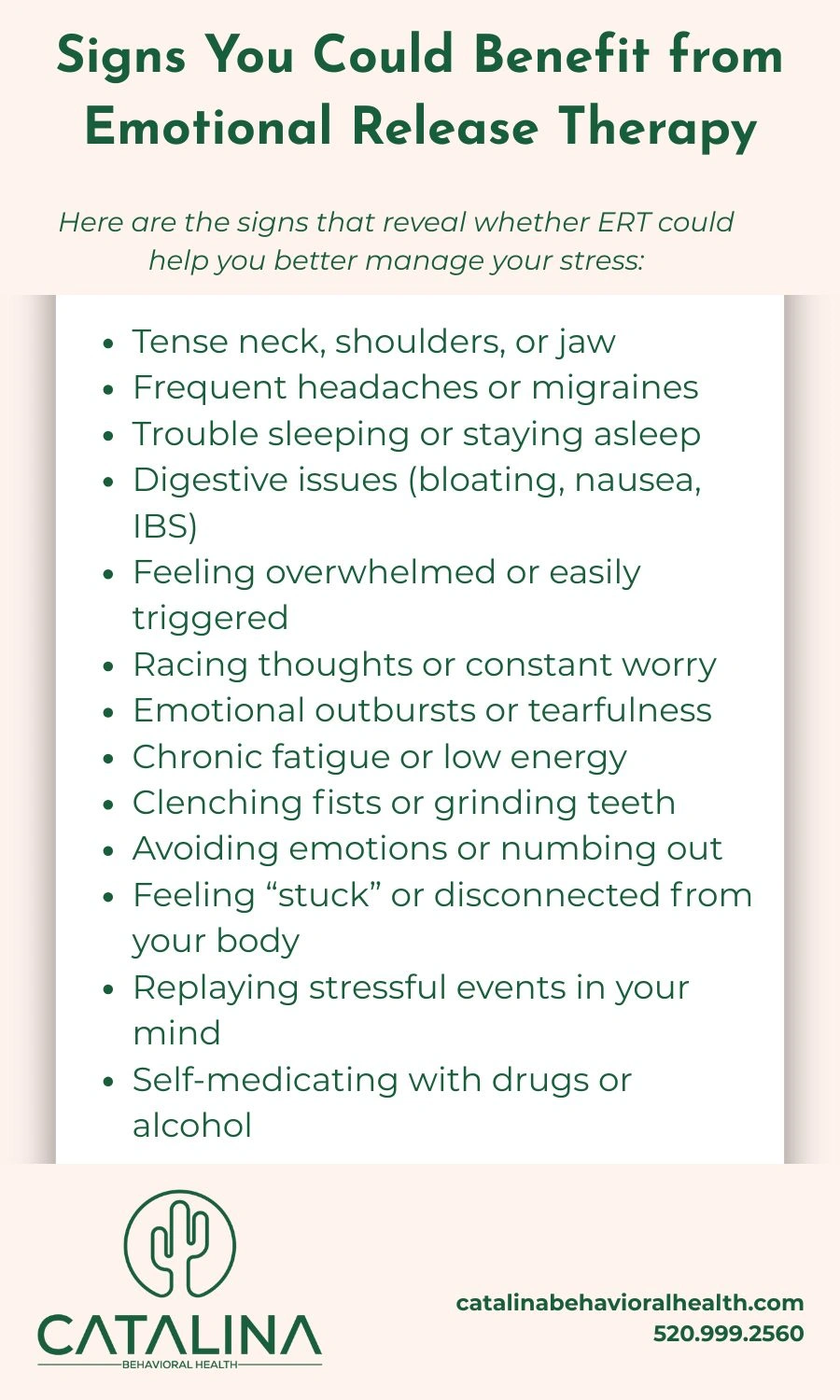The Benefits of Emotional Release for Mental And Physical Health
Emotional release therapy (ERT) is a healing approach that emphasizes the mind-body connection. It is based on the idea that trapped emotions become mental health and physical symptoms if left unprocessed. Therapy provides a safe space for clients to release stored emotional energy and effectively resolve their feelings.
Anyone experiencing emotional pain should know that it’s natural to feel negative emotions. Even if you are someone who has never had a formal mental health diagnosis, you, too, can experience a body stuck holding emotional baggage.
Catalina Behavioral Health can help anyone gain a better understanding of their emotions and help them break away from past trauma or pain trapped in their body.
Feeling stressed about past experiences doesn’t need to determine your entire future. Please keep reading to learn about the process of releasing emotions and how the catharsis can be life-changing.
Get Confidential Trauma and PTSD Assessment – Call Now!
Feeling Stressed? How It May Impact Your Well-being
Stress is more than a mental load. It can impact your entire body. Stress triggers your central nervous system to enter a state of survival mode. You might experience a faster heartbeat, tense muscles, and an increase in stress hormones flooding your body.
Over time, the constant state of tension can impact your immune system, sleep patterns, and digestive system. Emotionally, you can feel irritable, anxious, or even shut down.
Managing stress is a concept that many people prefer not to discuss. We all want to think that we’re doing the right things to stay calm and take care of our physical health. Most people can cope with minor stress, but when something unexpected or out of the ordinary happens, those affected are not equipped to deal with it.
Struggling with unchecked stress can lead to exaggerated emotions and outbursts. It also connects to numbing behaviors like substance use or binge eating. Emotional release therapy helps clients gain a deeper understanding of their trapped emotions. The emotional healing supports the nervous system, allowing it to reboot.
How ERT Facilitates Emotional Healing

Emotional release therapy techniques use a combination of evidence-based therapies, including:
- Somatic therapy
- Mindfulness meditation
- Trauma-informed bodywork
- Breathwork
These methods each help reduce anxiety, regulate emotions, and alleviate physical body symptoms of traumatic memories and stress. Catalina is a JCAHO-accredited treatment center with somatic healing and trauma-informed specialists who guide you as you cope with your anger, depression, and other negative emotions.
Felicity Worked on Releasing Emotions with the Catalina Team
“Felicity,” a past trauma client, is a good example. She needed help with guilt and grief after losing her spouse in a motorcycle accident. The emotions had accumulated in her mind and body, leaving her lethargic and with severe headaches and unpredictable emotional outbursts.
In her treatment process, Felicity worked with a counselor on mindfulness techniques to help her stay in the present moment instead of feeling constant regret. A massage therapist provided bodywork to release the tension she carried and had contributed to the headaches. Felicity also received grief counseling, learning how to live her life without her spouse.
She eventually came to accept the unfairness of the loss. She eventually came to make peace with much less struggling and more energy than before treatment.
What Trapped Emotions and Mental Health Challenges Benefit from ERT?

Will seeking emotional relief benefit you? If you are experiencing physical sensations because of the stress or anxiety you’re carrying in your body, you could be a good candidate.
Here are some mental health challenges that can benefit from ERT:
Negative Emotions: Emotional Release Therapy Can Help
- Unprocessed sorrow of sense of loss
- Suppressed rage or anger
- Chronic fear
- Anxiety or panic
- Emotional numbness
- Feelings of self-isolation
- Feeling stressed
- Emotions stemming from trauma or abuse
- Wounds from abandonment
ERT can help you process any trapped emotions that may harm your overall well-being.
Mental Health Challenges and ERT
If you have any of the following diagnosed conditions, emotional release therapy could be a good addition to your treatment plan:
- Post-traumatic stress disorder (PTSD)
- Anxiety disorders
- Panic attacks
- Depression or chronic sadness
- Bipolar depression
- Little interest in old hobbies/unwilling to try new things
- Tragic losses
- Somatic symptoms or chronic pain
- Emotional dysregulation
- Personality disorders
- Dissociation
- Substance use disorders or any addiction
Emotional release therapy sessions can help you bring the underlying fear and stress to the surface safely and help you achieve your treatment goals.
Get Accredited Treatment Programs at Catalina
Physical Symptoms May Improve with Emotional Release Therapy
Unprocessed emotions can become trapped in the body as stress, manifesting physically in many different ways. Here are some physical symptoms that stress poses a threat to your physical well-being:
- Chronic muscle tension
- Body aches
- Migraines and tension headaches
- Digestive problems (IBS, bloating, nausea)
- Fatigue or a lack of energy
- Sleep loss
- High blood pressure
- Jaw clenching
- Teeth grinding
- Skin breakouts (acne, hives)
These symptoms often improve as the emotional stress in the body is released through emotional release therapy.
Emotional Release Therapy at Catalina Behavioral Health

Do you have a sense that emotional release therapy could help invite peace back into your life? The Catalina Behavioral Health team often integrates ERT into our trauma treatment, addiction recovery programs, and other mental health services.
Our treatment plans are custom-designed to help each client break harmful old patterns and replace them with healthier habits that support peace and calm. Whether your condition is severe enough to require inpatient treatment or you plan to attend outpatient therapies, we can help you manage the stressors in your life.
Emotional Release Therapy and Substance Abuse Treatment
Many clients with substance use disorders use drugs or alcohol to mask the emotional pain present in their lives. ERT can be a game changer, allowing them to identify and release the feelings they’ve concealed with substances.
In SUDs treatment, our therapists combine ERT with cognitive-behavioral therapy, group therapy, and relapse prevention planning. Therapists provide clients with a range of tools to help process and release the complicated emotions they feel. ERT is an excellent way to support long-term healing.
Jenn Had ERT Sessions While Healing From Alcohol Abuse
‘Jenn’ came to Catalina for help with Alcohol Use Disorder. Her drinking problem was so severe that it led to a nasty divorce and supervised visitation with her children. It was her personal rock bottom, and she knew she couldn’t deal with recovery alone – she’d tried and relapsed on the first day.
Catalina offered Jenn a safe place to explore the emotional upheaval of her childhood, which had left her unequipped to cope with daily stress. After a safe detox, Jenn’s counselors used CBT, Narrative Therapy, and ERT sessions to help her learn to live without alcohol. After treatment, Jenn regained shared custody of her children and is teaching them the life skills her own parents had never taught her.
Trauma-Informed Treatment and Emotional Healing

A trauma-informed process means therapists provide clients with safety as they regain a sense of empowerment. Staying sensitive to past events is the key that helps counselors connect with trauma clients, with the process moving forward only after gaining the person’s trust.
In our trauma treatment programs, emotional release means careful guidance and proper timing, with the therapist helping the client throughout the process. Our team may incorporate techniques such as breathwork, mindfulness, and grounding exercises, helping each client process their emotions without reliving the traumatic event.
Mateo Suffered a Traumatic Injury, but ERT Helped
‘Mateo’ was a college soccer star, but his career aspirations to play with the pros ended after a severe leg injury. As his knee healed, it became clear he would never play at the same level again. Mateo mourned this loss and became hopelessly depressed and angry. Lashing out was unlike him – he’d become unrecognizable to his family.
At Catalina, he began dealing with the emotional and mental health aspects of this traumatic injury; he eventually came to grips with the loss through individual counseling and ERT sessions that helped him release the rage and unfairness of his situation. Mateo returned to college and completed his degree, at peace with his new path in life. He’s also stayed connected with the soccer world by coaching a youth league.
Treating Depression and Anxiety by Integrating Emotional Release Therapy
Depression and anxiety can both make people feel numb, tired, and even disconnected from their bodies. ERT serves as a body-centered approach to healing, providing clients with a deeper awareness and understanding of their feelings in a more meaningful way.
ERT doesn’t only rely on verbal processing; it allows clients to feel and then release their emotions, even when they cannot explain them. ERT for depression or anxiety often integrates with medication management, psychotherapy, and behavioral therapies.
ERT supports emotional flow and restores energy in those struggling with depression – an effective tool towards long-term depression or anxiety recovery.
ERT Helped Britt Stop Struggling with Depressed Feelings
‘Britt’ had felt depressed, dark feelings and thoughts since high school, when their peers often mocked and embarrassed them for not quite fitting in. The emotional uncertainty had even caused Britt to experience chronic headaches. After admitting they had been cutting themselves, Britt’s friends convinced them to seek professional care at Catalina.
Britt’s care plan included CBT and motivational interviewing to deal with their ambivalence about treatment. ERT helped them replace cutting with breathing exercises. After leaving Catalina, Britt maintains a healthy daily routine and continues deep breathing. They have also started yoga and plan to become a certified yogi.
What Age Group Is the Best Fit for Emotional Release Therapy?

ERT can be beneficial for many groups, but therapists can tailor the approach to suit the individual’s emotional readiness.
Teens or Adolescents
Our partners at Artemis Adolescent Healing Center can custom-fit ERT to help at-risk teens to cope with what feels to them like an uncertain world. Modified ERT sessions can help them learn to express their emotions, while body-based approaches help release stress faced by today’s teens. They gain awareness and a deeper understanding of self-efficacy.
Young Adults and Adults
Adults gain the most from ERT, mainly because this treatment helps them reflect on complex emotions. Many face many stressors in life, but haven’t had the tools to deal peer pressure and release it effectively.
ERT sessions help them gain a deeper understanding of why they feel a certain way. They also gain stress management tools to help them in life after therapy. ERT often complements other research-based treatment methods, tailored to an individual’s specific needs.
Up To 100% of Rehab Costs Covered By Insurance
Connect with Catalina For ERT Sessions and Treatment Options
ERT provides individuals with an understanding of the emotions that contribute to mental and physical health challenges, and offers a space to release negative energy. ERT sessions integrate seamlessly with our other mental health treatment programs and lead to deeper healing.
If you’re ready to release harmful feelings and replace them with more positive energy, we are here to help.
Call us today – we are here to listen and learn about your needs.





